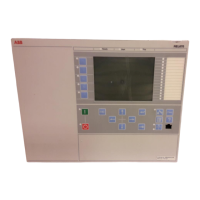additional resistive blinders in forward and reverse direction. The quadrilateral
characteristic limits the resistive reach and helps to avoid incorrect operations due
to load encroachment. All three zones have the same characteristic angle which can
be adjusted using ImpCharAng setting.
IEC15000196-2-en.vsdx
RFRevZx
RFFwZx
ImpCharAng
RFFwZx
RFRevZx RFFwZx
R(Ω)
jX(Ω)
R (Ω)
ZxFwd
ImpCharAng
ZxRev
jX(Ω)
IEC15000196 V2 EN-US
Figure 45: Non-directional quadrilateral and mho offset characteristic for
ZGTPDIS
7.3.2.1 Zone 1 operation
GUID-D5A94DC8-64AB-4623-88B6-64AD0AF5D53C v5
For transformer applications, the zone 1 element is typically set to see 70% of the
transformer impedance.
7.3.2.2 Zone 2 operation
GUID-F9622D3F-DDA1-451B-A1C6-71F030725D25 v5
Zone 2 can be used to cover the LV side of the transformer and the associated
busbar. It is usually set to cover 125% of the transformer impedance. The time to
trip must be provided in order to coordinate with the zone 1 element on the shortest
outgoing line from the bus.
7.3.2.3 Zone 3 operation
GUID-131391BB-2E2A-4EEB-B021-D996AEC84524 v4
Zone 3 covers the whole of the transformer, the interconnecting station bus to the
network and outgoing lines. Within its operating zone, the tripping time for this
relay should be coordinated with the longest time delay of the distance relays on
the outgoing LV lines.
7.3.3 Setting guidelines
GUID-292795EB-0605-4065-971D-169F55E2AFCF v5
Settings for underimpedance protection for transformers (ZGTPDIS) are done in
primary values. The instrument transformer ratio that has been set for the analog
Section 7 1MRK 506 375-UEN A
Impedance protection
152 Railway application RER670 2.2 IEC
Application manual

